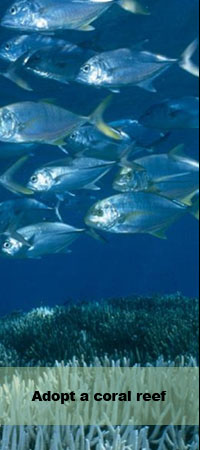|
The pace of coral reef decline is even faster than current trajectories by at least a decade. Reefs of the future will be remarkably different in structure and composition than reefs today and all could be wiped out within 50 years. For example, Japan's biggest coral reef has not recovered from bleaching due to in part rising sea temperatures, with only one percent of the reef in a healthy condition. The Great Barrier Reef in Australia is currently experiencing the worst coral die-off in recorded history after evaluating data collected during more than 900 dives along the 1,400-mile reef. In Barbados, ninety-nine percent of the coral reefs are being overfished provoking their destruction. Even in remote places far from direct human impacts, coral reefs are vanishing. In the Pacific Ocean, Upolu Island, one of the nine islands of Samoa, showed high decline with coral cover below 10 percent in over 80 percent of the 124 sites surveys in 2017.
The collapse of coral reefs has far-reaching implications for the entire ocean and for people, as reefs are considered sentinel ecosystems that protect coastal communities. We must do much more to save coral reefs, if not, the planet's remaining coral could all be wiped out in two generations.
Incredible life under water
Coral reefs are a biological marvel often touted as the largest living structure on Earth. Individual coral colonies may be up to 1,000 years old and many species in the genus of Porites can reach 200 years old. They can provide a mosaic of 4,000 individual coral species, 9,000 marine species, including more than 1,600 species of fish, six species of sea turtles, 30 species of marine mammals, and 14 species of sea snakes.
Urgent needs to fully integrate education on coral reefs along coastal communities
Public engagement with coral reefs in crisis is woefully low, especially by comparison with many other environmental crises.
Much more aggressive and long-term action and education from the top down to grassroots efforts to protect coral reefs are needed. Eighty percent of people surveyed along coastal communities in Southeast Asia (ESI survey 2017 Coral Triangle) showed a colossal gap on coral reef awareness. To save corals, every child living on tropical islands and along coastal environment must be ocean literate and know the direct and indirect benefits of corals by the time they reach 12 years of age. ESI has been engaged in conducting comprehensive coral reef and ocean education at schools in Southeast Asa since 2008.
Other actions that protect top marine predators, herbivorous fish species maintaining coral reef ecosystems, halt destructive fishing and overfishing, reduce marine pollution are part the solutions to adequality save and regain coral reefs on earth. Further, establishing many additional effective marine protected areas for corals and fish should be a priority for governments and NGOs.
Our goal: doubling the number of effective marine protected area within 10 years
ESI works on the ground to double the number of meaningful and effective marine protected areas where corals occur. Marine protected areas contribute to poverty reduction. They bring enormous benefits to fisherman communities and increase biodiversity and ecological resilience below water. In the Coral Triangle, especially in Indonesia, the Philippines, and Papua New Guinea, we must create more effective marine protected areas in light of rampant fish depletion and uncontrolled population growth.
In cases where the resources for enforcement are lacking (most of the time), ESI supports management regimes that are designed to meet community goals that achieve greater compliance and subsequent conservation success than regimes designed primarily for biodiversity conservation. Compliance with fishing restriction works when the community can perceive their direct and indirect benefits. Limited take closure systems that can serve the needs of a community and may provide a viable conservation alternative in situations where compliance with fully closed protected area regulations is low and resources for proper enforcement are untenable.
Underwater visual censuses of fish around the world have clearly showed significantly greater biomass and average size of fish species within the restricted areas (e.g., marine protected area) compared with areas without fishing restrictions. Therefore, regardless of their sizes (small or big), marine protected areas provide a significant increase in fish and tremendous benefits to local people.
Did you know sandy beaches and islands comes from coral reefs?
In and of themselves, coral reefs are extraordinary living structures: vast calcite scaffolds constructed by billions of tiny animals called polyps. But as clams, sponges, urchins, and fish naturally gnaw at the coral, they erode the reefs. The result: sand that can reshape, and even build, islands. Parrotfish are especially effective island builders—because of their prodigious pooping. When snorkeling or diving in a healthy reef, people can hear an incredible grinding noise, mostly from parrot fish, feeding and chewing up coral corals. Conclusion: we also need heathy coral reefs to maintain sandy beaches and islands.
Related links
|
|
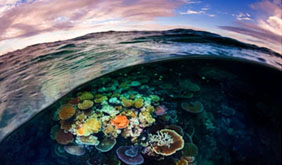
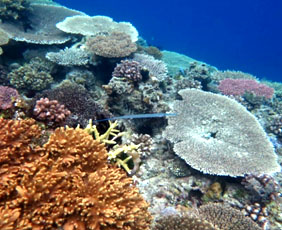
Coral reef site protected by ESI in the Coral Triangle. Endangered Species International
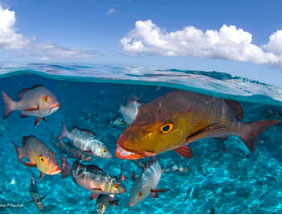
Marine protected areas bring back fish. Thomas P. Peschak
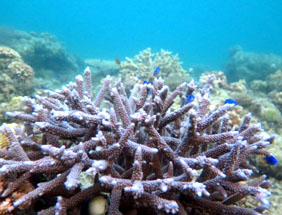
Corals are home of an incredible biodiversity. Endangered Species International
|


